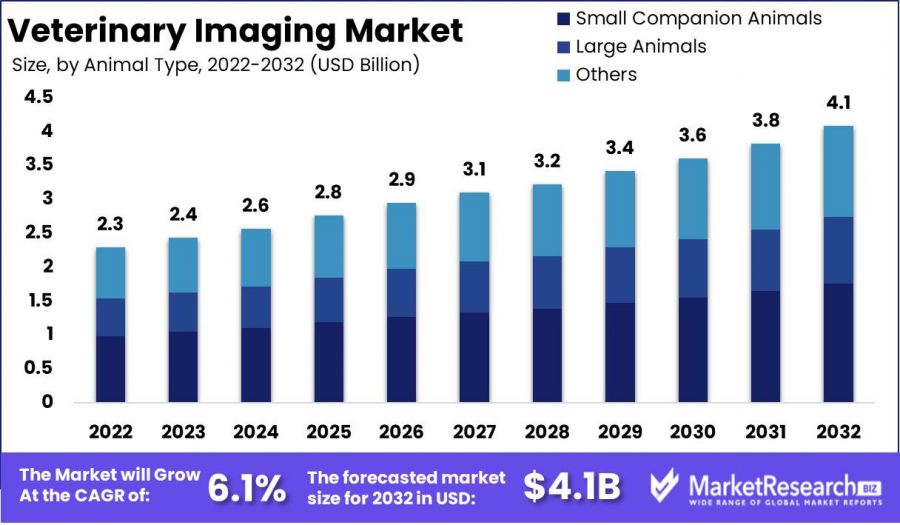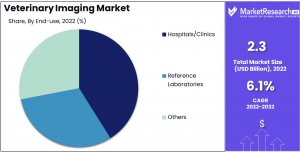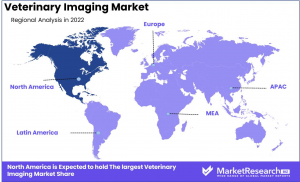
Veterinary Imaging Market Growing Steadily, Projected To Reach USD 4.1 Billion By 2032
Global Veterinary Imaging Market size is expected to be worth around USD 4.1 Bn by 2032 from USD 2.4 Bn in 2023, growing at a CAGR of 6.1%
NEW YORK, NY, UNITED STATES, February 10, 2025 /EINPresswire.com/ -- Overview
New York, NY – February 10, 2025 – Global Veterinary Imaging Market size is expected to be worth around USD 4.1 Bn by 2032 from USD 2.4 Bn in 2023, growing at a CAGR of 6.1% during the forecast period from 2023 to 2032.
Veterinary imaging plays a crucial role in diagnosing and treating various medical conditions in animals. It includes technologies such as X-rays, ultrasound, MRI, CT scans, and nuclear medicine to provide accurate and non-invasive diagnostics for pets, livestock, and exotic animals. These advanced imaging techniques help veterinarians detect diseases, fractures, and internal injuries, ensuring early intervention and effective treatment.
The increasing pet adoption rate and rising demand for advanced veterinary care are key drivers of the veterinary imaging market. Additionally, technological advancements, including AI-assisted diagnostics and portable imaging systems, are making veterinary imaging more efficient and accessible. The integration of digital radiography and telemedicine further enhances veterinary practice by allowing remote consultations and quick diagnosis.
Government initiatives promoting animal health and the rising number of veterinary hospitals and clinics are contributing to market growth. Moreover, the growing awareness of pet wellness and increased spending on companion animal healthcare are fueling the adoption of imaging solutions. With continued advancements in imaging technology and increasing investments in veterinary diagnostics, the future of veterinary imaging looks promising. It is set to revolutionize animal healthcare by providing precise, faster, and more efficient diagnostic solutions for veterinarians worldwide.
Unlock Competitive Advantages With Our PDF Sample Report @ https://marketresearch.biz/report/veterinary-imaging-market/request-sample/
Key Takeaways
•Market Growth: The veterinary imaging market is expanding due to rising pet adoption and increasing demand for advanced diagnostics.
•Advanced Imaging Technologies: X-rays, ultrasound, MRI, CT scans, and nuclear medicine play a key role in early disease detection and treatment.
•AI & Digital Integration: AI-assisted diagnostics, digital radiography, and telemedicine enhance efficiency and accessibility in veterinary imaging.
•Increased Pet Healthcare Spending: Growing awareness of pet health is driving higher investments in veterinary care and imaging solutions.
•Portable Imaging Systems on the Rise: Mobile and handheld imaging devices are improving access to veterinary diagnostics, especially in remote areas.
•Livestock & Companion Animal Care: Veterinary imaging is essential for both pets and farm animals, ensuring disease prevention and better healthcare.
•Government & Private Sector Investments: Supportive policies and funding for veterinary healthcare are boosting imaging technology adoption.
•Growing Veterinary Clinics & Hospitals: The increasing number of veterinary facilities worldwide is fueling demand for advanced imaging solutions.
•Non-Invasive & Early Detection: Imaging technologies enable early diagnosis of diseases and injuries, improving treatment outcomes for animals.
Segmentation Analysis
•By Product Analysis: The X-ray segment dominates the veterinary imaging market due to its affordability, ease of use, and widespread adoption. Despite advancements in MRI and CT scans, X-ray remains the most preferred imaging modality. Growing consumer awareness, increased spending on pet healthcare, and technological improvements in X-ray imaging are driving market expansion. Its lower cost and improved efficiency are expected to boost adoption in the coming years.
•By Animal Type Analysis: The small companion animals segment leads the veterinary imaging market, driven by the increasing pet population, particularly dogs and cats. Rising disposable income and pet humanization trends encourage owners to seek advanced veterinary care. Preventive healthcare and early disease detection are key growth factors. The segment is expected to expand rapidly as more consumers invest in high-quality imaging services for their pets.
•By Application Analysis: The orthopedics and traumatology segment holds the largest market share due to the high prevalence of bone and joint injuries in animals. Rising demand for advanced imaging solutions in diagnosing fractures, joint disorders, and trauma-related conditions is fueling growth. Increased awareness and pet owner willingness to invest in preventive care will continue to drive segment expansion in the coming years.
•By End-User Analysis: Hospitals and clinics dominate the veterinary imaging market, offering comprehensive diagnostic services with advanced imaging technology. These facilities attract pet owners seeking specialized care, early disease detection, and treatment. The segment is set to grow as the demand for sophisticated veterinary healthcare services rises, along with the adoption of cutting-edge imaging equipment in hospitals and veterinary clinics.
Market Segments
By Product
•Instrument
○Radiography X-ray
-Direct (Capture) Radiography
-Computed Radiography
-Film-based Radiography
○Ultrasound Imaging
-2D Ultrasound Imaging
-3D/4D Ultrasound Imaging
-Doppler Imaging
○MRI
○CT Imaging
-Multi-slice CT
-Single-slice CT
○Video Endoscopy Imaging
○Others
•Reagent
○Ultrasound Contrast Regents
○MRI Contrast Regents
○X-Ray/CT Contrast Reagents
○Nuclear Imaging
•Services
○Interventional Radiology & Endoscopy
○Teleradiology
○Advanced Imaging Services
•Veterinary PACS
○RIS PACS
○CVIS PACS
By Animal Type
•Small Companion Animals
•Large Animals
•Others (Including Exotic Animals and Birds)
•By Application
•Orthopedics and Traumatology
•Oncology
•Cardiology
•Neurology
•Other (dentistry & ophthalmology)
By End-use
•Hospitals/Clinics
•Reference Laboratories
•Others
Buy This Premium Research Report: https://marketresearch.biz/purchase-report/?report_id=15854
Market Dynamics
Driver: The veterinary imaging market is primarily driven by the increasing recognition of animal welfare and health. Advanced imaging technologies, such as MRI and CT scans, enable early detection and treatment of diseases in animals, improving outcomes. This focus on animal well-being has led to greater adoption of sophisticated diagnostic tools in veterinary medicine.
Trend: A notable trend in the veterinary imaging market is the integration of metabolomics with imaging techniques. This combination enhances the assessment of animal welfare by providing comprehensive insights into metabolic changes associated with various health conditions. Such integrative approaches are paving the way for more precise diagnostics and personalized treatments in veterinary care.
Restraint: Despite advancements, the veterinary imaging market faces challenges due to the impact of stress and anesthesia on animals during imaging procedures. Stress and anesthesia can alter physiological parameters, potentially affecting diagnostic accuracy and animal welfare. Addressing these issues requires the development of less invasive imaging techniques and improved animal handling protocols.
Opportunity: The growing emphasis on animal welfare presents significant opportunities for the veterinary imaging market. Innovations in non-invasive imaging technologies and the development of portable imaging devices can enhance diagnostic capabilities in various settings, including field conditions. Additionally, integrating imaging data with other diagnostic modalities can lead to more comprehensive health assessments, improving animal care.
Market Key Players
•DEXX Laboratories, Inc.
•GE Healthcare
•Carestream Health
•FUJIFILM Holdings America Corporation
•Esaote SpA
•VetZ Limited
•Hallmarq Veterinary Imaging Ltd
•SUNI Medical Imaging, Inc.
•Universal Medical Systems, Inc.
Emerging Trends in Veterinary Imaging
•Artificial Intelligence (AI) Integration: AI is increasingly being used in veterinary imaging to enhance diagnostic accuracy. Machine learning algorithms assist in detecting and classifying abnormalities in radiographs and other imaging modalities, leading to more precise and efficient diagnoses. For instance, AI applications have been developed to identify specific diseases in animals through imaging data.
•Advanced Imaging Modalities: Beyond traditional radiography and ultrasonography, advanced imaging techniques like computed tomography (CT) and magnetic resonance imaging (MRI) are becoming more prevalent in veterinary practice. These modalities offer detailed cross-sectional images, aiding in the diagnosis of complex conditions such as neurological disorders and intricate fractures.
•Hybrid Imaging Techniques: Combining different imaging modalities, such as PET-CT or PET-MRI, provides both anatomical and functional information, enhancing diagnostic capabilities. These hybrid techniques are increasingly utilized in veterinary medicine to improve disease detection and treatment planning.
Use Cases in Veterinary Imaging
•Orthopedic Assessments: Radiography is commonly used to evaluate musculoskeletal issues in animals. For example, X-rays are employed to diagnose fractures, joint dislocations, and bone tumors in pets. Studies have shown that radiography is effective in identifying these conditions, facilitating timely surgical interventions.
•Neurological Evaluations: MRI is the preferred imaging modality for assessing neurological conditions in animals. It provides detailed images of the brain and spinal cord, aiding in the diagnosis of issues like intervertebral disc disease, brain tumors, and spinal cord injuries. Research indicates that MRI has a high diagnostic yield in identifying these conditions, leading to improved treatment outcomes.
•Oncological Imaging: Advanced imaging techniques, such as CT and MRI, are utilized to detect and stage cancers in animals. These modalities help in determining tumor size, location, and metastasis, which are crucial for treatment planning. Studies have demonstrated that the use of CT and MRI in oncological imaging enhances the accuracy of cancer staging and monitoring.
Lawrence John
Prudour
+91 91308 55334
email us here
Distribution channels: Healthcare & Pharmaceuticals Industry
Legal Disclaimer:
EIN Presswire provides this news content "as is" without warranty of any kind. We do not accept any responsibility or liability for the accuracy, content, images, videos, licenses, completeness, legality, or reliability of the information contained in this article. If you have any complaints or copyright issues related to this article, kindly contact the author above.
Submit your press release


